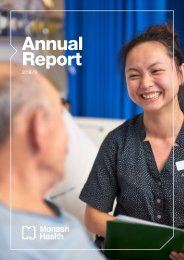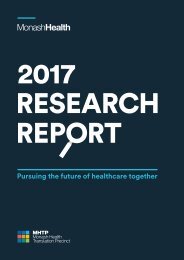Low Res MH Quality Account 2018 FINAL
Create successful ePaper yourself
Turn your PDF publications into a flip-book with our unique Google optimized e-Paper software.
40 Monash Health<br />
Maternity services<br />
Monash Women’s and<br />
Newborn Program<br />
encompasses maternity,<br />
gynaecology and newborn<br />
services across four<br />
hospitals: Monash Medical<br />
Centre, Dandenong,<br />
Moorabbin and Casey. It is<br />
the largest maternity and<br />
newborn service in Victoria,<br />
providing care to over<br />
9,000 women giving birth<br />
to more than 10,000 babies<br />
each year.<br />
The Victorian Perinatal Services<br />
Performance Indicator (VPSPI) report<br />
presents and discusses outcome<br />
data on key performance areas of<br />
perinatal care.<br />
Two specific performance areas<br />
studied were the rate of severe fetal<br />
growth restriction (FGR) at 40 weeks<br />
gestation, and the readmission levels<br />
of mothers and babies within 28 days<br />
of discharge. Data is site specific<br />
(MMC, DH, CH) rather than Monash<br />
Health overall.<br />
FGR refers to a condition in which<br />
a fetus is unable to achieve its<br />
genetically determined potential<br />
size. The challenge for clinicians<br />
is to identify fetuses whose health<br />
is endangered and to monitor and<br />
intervene appropriately because<br />
of the associated risk of perinatal<br />
mortality with severe FGR as<br />
pregnancy advances.<br />
This is a priority area for improved<br />
performance across Monash Health.<br />
Key to this is ensuring women attend<br />
their first antenatal visit before 12<br />
weeks’ gestation. Reducing the<br />
ultrasound wait time for women<br />
identified as at risk of fetal growth<br />
restriction in the third trimester is<br />
another strategy to address the issue<br />
of FGR.<br />
Detection of FGR at Monash Medical<br />
Centre was excellent in the most<br />
favourable quartile, despite the very<br />
high-risk patient population and<br />
large number of births. Expanded<br />
perinatal services, improved access<br />
to ultrasound, new clinical practice<br />
guidelines, dedicated quality meetings,<br />
and team accountability contributed to<br />
the strong result.<br />
Although FGR was detected in most<br />
cases, not all mothers were agreeable<br />
to earlier delivery, hence the rate at 40<br />
weeks remains higher than preferred.<br />
Casey Hospital<br />
is currently at or<br />
below the state<br />
average, which is a<br />
favourable position,<br />
reflecting a strong<br />
multidisciplinary<br />
team culture for<br />
clinical excellence<br />
and education, and<br />
the improved access<br />
to ultrasound services<br />
delivered through the<br />
Perinatal Excellence<br />
Committee.<br />
Stillbirth Australia and SCV Fetal<br />
Growth <strong>Res</strong>triction workshops<br />
commenced across the state in July<br />
<strong>2018</strong> to build clinicians’ skills in the<br />
detection of FGR with much of this<br />
work based on the success of the<br />
Casey approach.<br />
Dandenong Hospital showed<br />
outcomes above the target, however,<br />
the low numbers involved highlight<br />
the statistical complexity in the<br />
definition of this indicator. All babies<br />
appropriately detected by Dandenong<br />
and Casey and referred to Monash<br />
Medical Centre so they no longer<br />
feature in the statistics at their site<br />
because the birth usually occurs<br />
at MMC. This issue is unique to<br />
Monash Health.<br />
A new fetal surveillance unit is being<br />
established at Dandenong and<br />
Casey Hospitals to improve access<br />
to ultrasound and fetal monitoring<br />
services. This means women won’t<br />
need referral to MMC for these<br />
services and will improve their overall<br />
patient experience.<br />
Readmissions of mothers was above<br />
target at Casey Hospital. All cases<br />
were reviewed, with 50% of cases not<br />
warranting readmission as they could<br />
have been managed as an outpatient,<br />
and several cases were Emergency<br />
Department presentations not<br />
requiring admission to the ward area.<br />
Education and development of junior<br />
medical staff was undertaken to<br />
assist them in recognising when it<br />
is appropriate to escalate cases to<br />
senior medical staff for advice on the<br />
appropriateness of admission.<br />
Monash Medical Centre and<br />
Dandenong Hospital were below the<br />
target, while readmissions of babies<br />
were below target at all sites.<br />
The Women’s and Newborn Program<br />
have partnered with the Business<br />
Intelligence unit to develop a ‘real<br />
time’ performance dashboard for the<br />
perinatal indicators; this allows for<br />
monthly review of performance and<br />
timely improvement activities.








